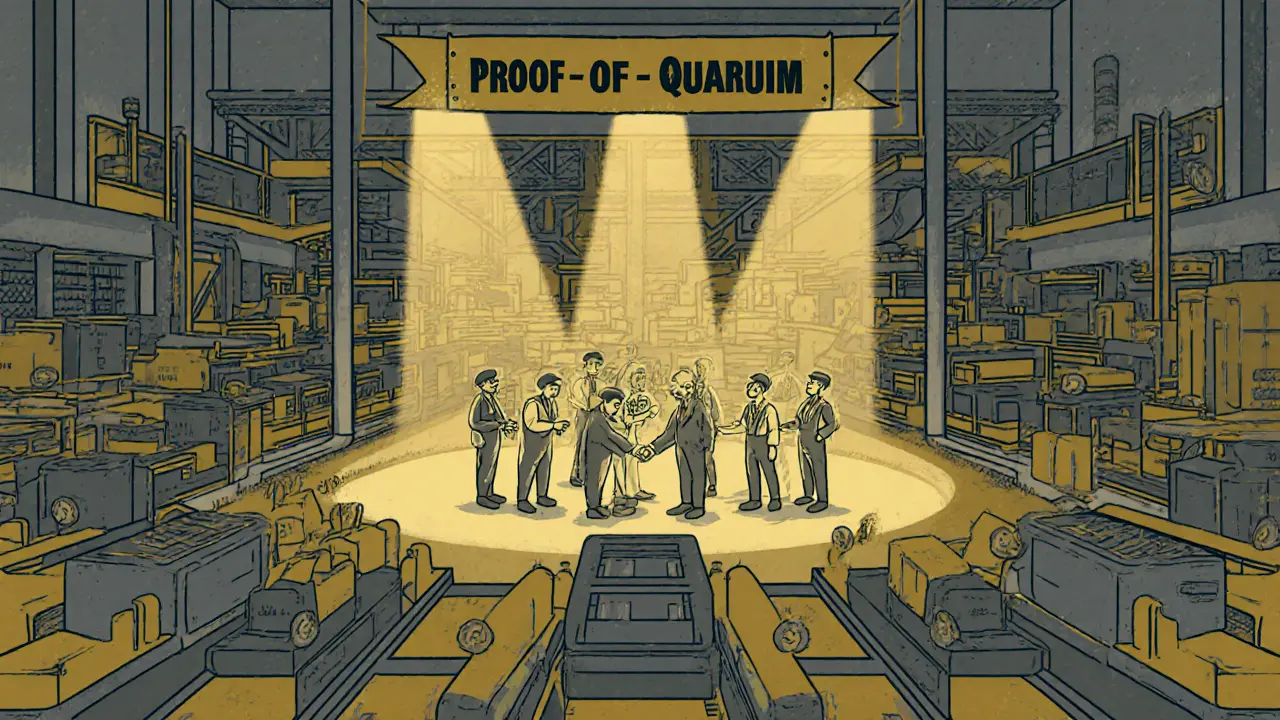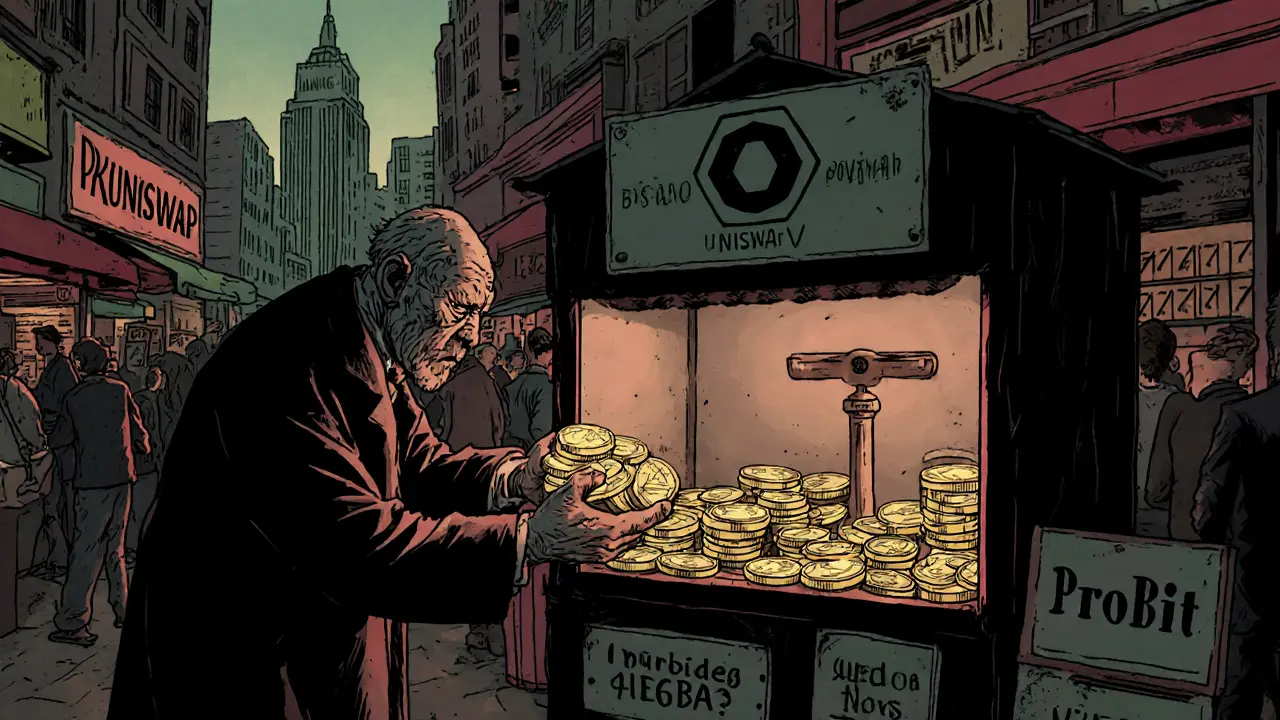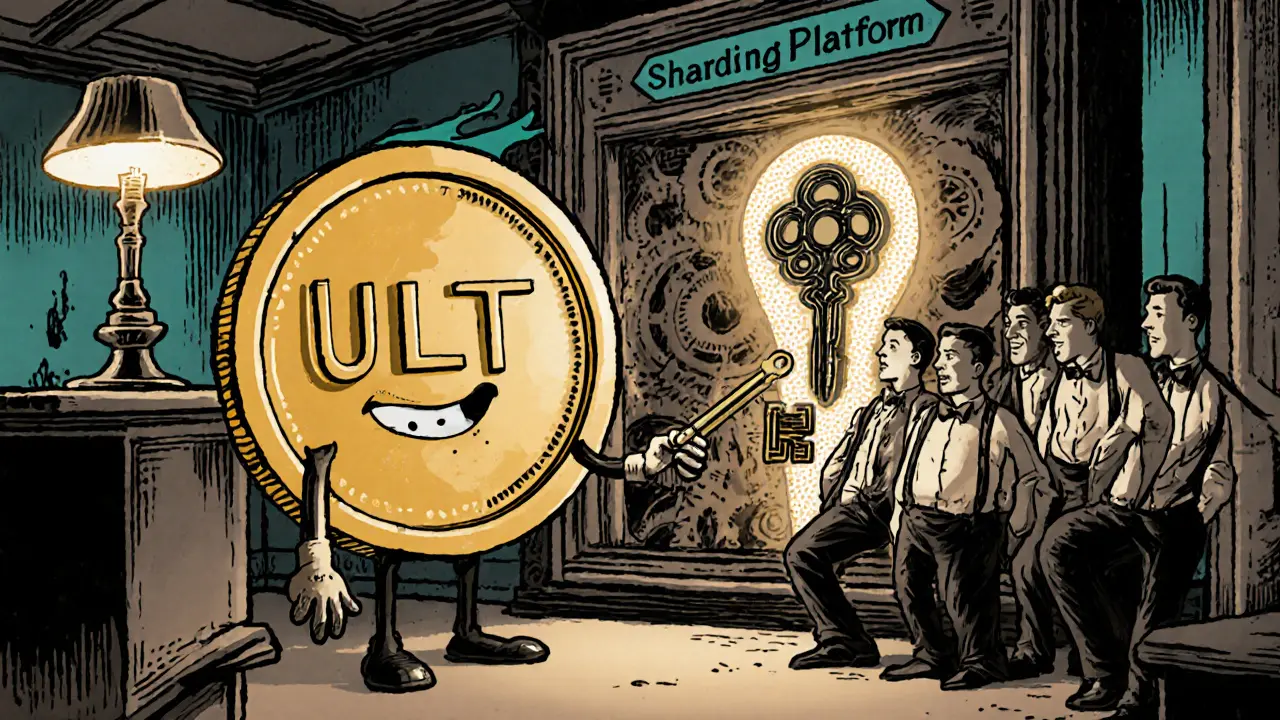ULT Token Valuation Calculator
Token Metrics
Network Adoption
Valuation Inputs
Projected Valuation Results
TL;DR
- Shardus (ULT) is an ERC‑20 token that licenses a sharding‑focused distributed ledger platform.
- The platform uses a Proof‑of‑Quorum‑based Consensus Algorithm to scale to billions of users.
- Networks built on Shardus must allocate at least 1% of their supply to ULT holders, creating a revenue‑share model.
- Trading is limited to Uniswap V3 (Polygon) and a few small exchanges, with daily volume under $10.
- Analysts are bearish; price forecasts hover between $0.04 and $0.08 through 2035.
What is Shardus (ULT)?
Shardus is an ERC‑20 cryptocurrency token that serves as the licensing mechanism for Shardus distributed ledger software. Originally launched as the “Unblocked Ledger Token,” the token carries the ticker ULT and is intended for developers, not retail speculation.
The token itself does not power a native blockchain. Instead, it unlocks access to a suite of sharding‑enabled infrastructure that can be embedded in any public network. By holding ULT, participants earn a slice of licensing fees collected from projects that adopt the technology.
Technical Architecture
The heart of the platform is the Shardus Consensus Algorithm a Proof‑of‑Quorum system that coordinates node agreement without the energy waste of Proof‑of‑Work. Nodes are grouped into shards, each handling a fraction of the total transaction load and state data. As more users join, new shards are spun up automatically, keeping throughput linear.
Proof‑of‑Quorum (PoQ) works by requiring a quorum of validators from each shard to sign off on a block before it becomes final. Because each shard only needs a subset of the total validators, block finality is reached in milliseconds, and the network avoids the bottlenecks typical of single‑chain designs.
Sharding also means state storage is distributed. Instead of every node keeping a full copy of the ledger, each node maintains only the data relevant to its shard. This reduces hardware requirements dramatically, allowing the system to support billions of active users without sacrificing decentralization.
Licensing Model & Revenue Share
Projects that want to build on Shardus must pay a licensing fee in ULT. The fee is structured as a mandatory allocation of at least 1% of the project’s total token supply to the existing ULT holder pool. This creates a continuous revenue stream for token holders while granting the network rights to the sharding technology.
The model is deflationary in practice: as more networks adopt Shardus, the total amount of ULT locked for licensing grows, potentially reducing circulating supply and putting upward pressure on price-provided demand holds steady.

Current Market Data (October2025)
Price data varies by source. CoinGecko lists ULT at $0.07459 with a 24‑hour volume of $23.93, while CoinMarketCap shows $0.06958 and a volume of $48.23. The token’s market capitalization is reported anywhere from $31million (CoinGecko) to $150million (P2P.Army), reflecting inconsistent supply reporting.
Trading venues are sparse. The most active pair is ULT/WETH on Uniswap V3 (Polygon), generating roughly $2.5 in 24‑hour volume. ProBit offers a ULT/USDT market with about $53 of volume, accounting for two‑thirds of total activity. Daily volume has plunged nearly 98% from the previous day, suggesting limited liquidity.
Historical performance shows high volatility: a 31% gain over 14days, a 19.85% loss in the last 24hours, and a 43.9% increase over the past year. The token sits about 96.6% below its all‑time high but 221.8% above its all‑time low.
Real‑World Implementations
Two public networks are currently built on the Shardus framework:
- Shardeum - a scalable, EVM‑compatible chain that markets itself as “infinite scalability.”
- Liberdus - a privacy‑focused ledger that leverages Shardus sharding for low‑cost transactions.
Both projects require ULT licensing fees, meaning token holders benefit directly from any growth these networks achieve.
Risks & Analyst Outlook
Analyst platform 3Commas currently labels ULT with a “Sell” recommendation. Short‑term price targets sit near $0.073, while long‑term forecasts through 2035 average $0.050, with a maximum projection of $0.078. The consensus is a bearish outlook, citing low liquidity, fragmented market data, and reliance on licensing adoption as key concerns.
Investors should also watch the token’s distribution model. The project does not sell its own tokens; instead, it rewards contributors. This means market supply is tied to development activity, which can be unpredictable.
Regulatory risk is modest-ULT is classified as a utility token for software licensing, but any shift in how authorities view tokenized licensing could impact price.
How to Buy & Trade ULT
- Set up a Web3 wallet (MetaMask, Trust Wallet, etc.) that supports the Polygon network.
- Obtain some MATIC or ETH on Polygon to cover transaction fees.
- Navigate to Uniswap V3 (Polygon) and paste the ULT contract address:
0x... (example address)into the token selector. - Swap your MATIC/ETH for ULT, adjusting slippage to at least 2% due to low liquidity.
- If you prefer centralized venues, create an account on ProBit, verify KYC, then trade the ULT/USDT pair.
Because daily volume is tiny, expect noticeable price impact on larger orders. Consider using limit orders and checking real‑time depth charts before executing trades.
Quick Comparison: Shardus vs. Typical ERC‑20 Tokens
| Feature | Shardus (ULT) | Standard ERC‑20 Token |
|---|---|---|
| Primary Purpose | Licensing for sharding‑enabled ledger software | Utility/asset for various dApps |
| Consensus Dependency | Proof‑of‑Quorum Shardus Consensus | None (depends on host blockchain) |
| Revenue Model | 1% of supply from licensed networks | Typically none, unless tokenomics include fees |
| Liquidity | Very low; only Uniswap V3 (Polygon) & ProBit | Often high; listed on many exchanges |
| Adoption Metric | Number of networks using Shardus (e.g., Shardeum, Liberdus) | User base of token’s native dApp |

Frequently Asked Questions
What does the ULT token actually do?
ULT is a licensing token. Projects that want to run a blockchain on Shardus must set aside at least 1% of their own token supply for ULT holders. In return, they get access to the sharding technology and the holders earn a share of the licensing fees.
Is Shardus a blockchain itself?
No. Shardus is a distributed ledger framework that other blockchains can embed. It provides the consensus and sharding layer, but it does not have its own native chain or coin beyond the ULT token used for licensing.
Where can I buy ULT?
The most liquid market is the ULT/WETH pair on Uniswap V3 (Polygon). A smaller option is the ULT/USDT pair on ProBit. You’ll need a wallet that supports the Polygon network and some MATIC or ETH for gas.
Why is the trading volume so low?
ULT’s utility is tied to licensing, not everyday transactions. Only a handful of projects pay fees in ULT, and the token is not marketed as a speculative asset, which keeps daily volume minimal.
What are the main risks of holding ULT?
Risks include low liquidity, price volatility, dependence on the success of Shardus‑based networks, and a bearish analyst outlook. A regulatory change affecting tokenized licensing could also affect demand.
How does Proof‑of‑Quorum differ from Proof‑of‑Stake?
Proof‑of‑Quorum requires a subset of validators from each shard to reach a quorum before a block is finalized. Unlike Proof‑of‑Stake, there is no staking of native tokens; validators are selected based on reputation and stake in the underlying network, which reduces energy consumption and speeds finality.
What projects are already using Shardus technology?
Shardeum and Liberdus are two publicly launched chains that have integrated Shardus’s sharding and consensus modules. Both require ULT licensing fees, meaning token holders benefit from their growth.


victor white
September 25, 2025 AT 19:15The veil of mainstream crypto analysis obscures the hidden machinations steering ULT's stagnant liquidity.
mark gray
September 25, 2025 AT 20:39Shardus’ licensing model is interesting because it aligns token holder incentives with real‑world software adoption, though the actual revenue streams are currently tiny.
Anthony R
September 25, 2025 AT 22:02Reading the token metrics, you see a modest market cap, a low volume, and a price that hovers around the $0.07 mark, which suggests the token is still in a discovery phase, and investors should be aware of the liquidity constraints, especially when planning larger moves, and consider the impact of slippage on any trade.
Vaishnavi Singh
September 25, 2025 AT 23:25The idea of a utility token that funds infrastructure reminds me of a Socratic dialogue about means and ends; the token is a means, yet its value is derived from the ends it enables.
Cindy Hernandez
September 26, 2025 AT 00:49For anyone looking to buy ULT, start by securing some MATIC for Polygon gas, then use Uniswap V3’s interface to swap; remember to set a modest slippage tolerance because the order book is thin.
Karl Livingston
September 26, 2025 AT 02:12It’s fascinating how the PoQ consensus reduces energy consumption, yet the real test will be whether developers adopt it at scale.
That could turn the licensing fees into a meaningful revenue stream.
Only time will tell if the sharding promise lives up to the hype.
Kyle Hidding
September 26, 2025 AT 03:35The tokenomics are a textbook case of speculative veneer masking a fundamentally flawed revenue model; without a clear pipeline of licensed networks, the projected upside is nothing more than a speculative mirage, and the high‑volatility tag is absolutely warranted.
Andrea Tan
September 26, 2025 AT 04:59Hey, I get why the volume is low – the token’s purpose isn’t everyday transactions, it’s more of a licensing stake. Just keep that in mind when you’re setting expectations.
Cody Harrington
September 26, 2025 AT 06:22We could all benefit from sharing more data on the actual usage of Shardus in the two public networks; that transparency would help the community gauge real demand.
Chris Hayes
September 26, 2025 AT 07:45While the critique of revenue scarcity is noted, it’s also true that early‑stage platforms often experience a bootstrapping period before fees materialize; dismissing the token solely on current volume may overlook future upside.
Millsaps Delaine
September 26, 2025 AT 09:09One must first acknowledge the inherent elegance of Shardus’ design, which endeavors to reconcile scalability with decentralization-an ambition that few projects have genuinely pursued.
Its Proof‑of‑Quorum consensus, while less heralded than Proof‑of‑Stake, offers a nuanced compromise between security and throughput.
The act of allocating a mere one percent of a project's token supply for licensing is, on paper, a modest demand that could engender a sustainable revenue stream for ULT holders.
Nevertheless, the market’s reception to such a model remains tepid, as evidenced by the minuscule daily volume across exchanges.
Liquidity, or the lack thereof, is a pivotal factor that can stifle price discovery and exacerbate volatility.
Investors should therefore be wary of the potential for significant slippage on any sizable order.
Nonetheless, the token’s utility is not merely speculative; it provides a tangible claim on licensing revenue, which, if the ecosystem expands, may yield meaningful returns.
Two current networks-Shardeum and Liberdus-already integrate Shardus technology, creating a nascent foundation for broader adoption.
Each additional network could incrementally increase the licensing pool, thereby augmenting the token’s intrinsic value.
Nonetheless, the current growth trajectory appears sluggish, with only a handful of public implementations after several years of development.
Analyst sentiment, as reflected by a consensus “Sell” rating, underscores a prevailing skepticism within the broader crypto community.
Such bearish outlooks often stem from concerns about insufficient liquidity, fragmented market data, and the project's reliance on a narrowly defined use case.
Regulatory risk, albeit modest, cannot be dismissed; any shift in the classification of utility tokens could materially impact the token’s standing.
In sum, Shardus presents a compelling technological proposition, yet its market performance is hampered by limited adoption, thin trading volume, and a pervasive bearish narrative.
Irene Tien MD MSc
September 26, 2025 AT 10:32Ah, the ever‑so‑trustworthy world of crypto analysts, sprinkling their “Sell” recommendations like fairy dust while the poor little ULT token trembles in the shadows of obscurity.
One must wonder whether the bearish forecasts are rooted in genuine research or merely the echo chamber of hype‑chasing pundits who thrive on fear.
The licensing model, though quaint, is painted as a dead end, as if the modest one‑percent fee could never blossom into a respectable revenue stream.
Yet, history is littered with projects that were dismissed as “too niche” before they quietly amassed a dedicated user base.
Low liquidity? Sure, but that’s a symptom of the market’s reluctance to understand nuanced utility tokens, not a fatal flaw.
And those damned volume numbers-$23.93 here, $48.23 there-are tossed around like bad jokes, never accounting for the exponential potential once a few more networks adopt the framework.
Perhaps the real conspiracy lies in the data aggregators themselves, choosing to underreport the true supply figures to keep the narrative of volatility alive.
Meanwhile, the token’s developers continue to push forward, embedding Shardus into Shardeum and Liberdus, quietly building the very foundation the analysts claim is insufficient.
In the grand tapestry of blockchain innovation, ULT may simply be the underdog waiting for its moment to shine, a hidden gem cloaked in the fog of mainstream disregard.
kishan kumar
September 26, 2025 AT 11:55Esteemed participants, one must contemplate the philosophical ramifications of a token that serves as a conduit for licensing-an embodiment of the Platonic form of utility, perhaps?
While the market may deem such constructs trivial, the underlying premise aligns with the Aristotelian notion of telos: the purpose of a token is to facilitate a greater good, namely the propagation of sharding technology.
That being said, the present paucity of liquidity should not be misconstrued as an indictment of worth; rather, it reflects a nascent stage of adoption, much like the early chapters of any great treatise.
In conclusion, let us observe with measured patience, for the true value may yet emerge as the ecosystem matures. :)
Samuel Wilson
September 26, 2025 AT 13:19Well articulated; maintaining a balanced perspective while acknowledging both the technical promise and the current market constraints is precisely the guidance newcomers need. Stay disciplined, and remember that incremental progress often outpaces dramatic headlines.